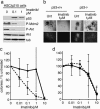Loss of p53 impedes the antileukemic response to BCR-ABL inhibition
- PMID: 16651519
- PMCID: PMC1455409
- DOI: 10.1073/pnas.0602402103
Loss of p53 impedes the antileukemic response to BCR-ABL inhibition
Abstract
Targeted cancer therapies exploit the continued dependence of cancer cells on oncogenic mutations. Such agents can have remarkable activity against some cancers, although antitumor responses are often heterogeneous, and resistance remains a clinical problem. To gain insight into factors that influence the action of a prototypical targeted drug, we studied the action of imatinib (STI-571, Gleevec) against murine cells and leukemias expressing BCR-ABL, an imatinib target and the initiating oncogene for human chronic myelogenous leukemia (CML). We show that the tumor suppressor p53 is selectively activated by imatinib in BCR-ABL-expressing cells as a result of BCR-ABL kinase inhibition. Inactivation of p53, which can accompany disease progression in human CML, impedes the response to imatinib in vitro and in vivo without preventing BCR-ABL kinase inhibition. Concordantly, p53 mutations are associated with progression to imatinib resistance in some human CMLs. Our results identify p53 as a determinant of the response to oncogene inhibition and suggest one way in which resistance to targeted therapy can emerge during the course of tumor evolution.
Conflict of interest statement
Conflict of interest statement: No conflicts declared.
Figures




References
-
- Sawyers C. Nature. 2004;432:294–297. - PubMed
-
- Weinstein I. B. Science. 2002;297:63–64. - PubMed
-
- Jonkers J., Berns A. Cancer Cell. 2004;6:535–538. - PubMed
-
- Gorre M. E., Mohammed M., Ellwood K., Hsu N., Paquette R., Rao P. N., Sawyers C. L. Science. 2001;293:876–880. - PubMed
-
- Shah N. P., Tran C., Lee F. Y., Chen P., Norris D., Sawyers C. L. Science. 2004;305:399–401. - PubMed
Publication types
MeSH terms
Substances
Grants and funding
LinkOut - more resources
Full Text Sources
Other Literature Sources
Medical
Research Materials
Miscellaneous

